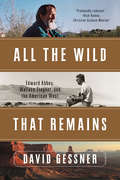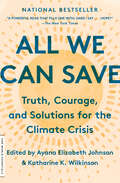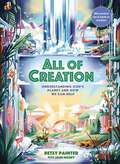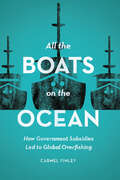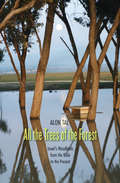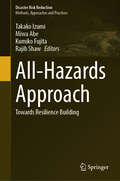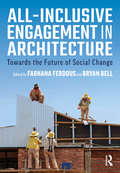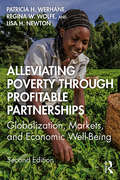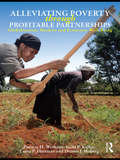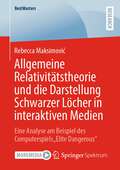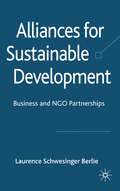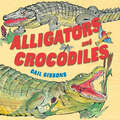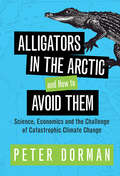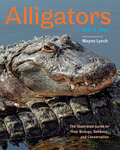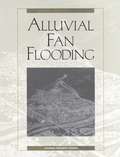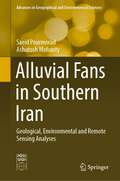- Table View
- List View
All That the Rain Promises and More: A Hip Pocket Guide to Western Mushrooms
by David Arora&“[All That the Rain Promises and More] is certainly the best guide to fungi, and may in fact be a long lasting masterpiece in guide writing for all subjects.&”—Roger McKnight, The New York TimesMushrooms appeal to all kinds of people—and so will this handy pocket guide, which includes key information for more than 200 Western mushroomsOver 200 edible and poisonous mushrooms are depicted with simple checklists of their identifying features, as David Arora celebrates the fun in fungi with the same engaging bend of wit and wisdom, fact and fancy, that has made his comprehensive guide, Mushrooms Demystified, the mushroom hunter&’s bible.&“The best guide for the beginner. I&’d buy it no matter where I lived in North America.&”—Whole Earth Catalog
All The Dark Secrets: The First Heartwarming, Heartrending Saga In The Beloved Families Of Fairley Terrace Series (The\families Of Fairley Terrace Ser. #1)
by Jennie FeltonAll The Dark Secrets is a powerful saga in the Families of Fairley Terrace series from Jennie Felton, in the grand tradition of Katie Flynn, Dilly Court and Josephine Cox, of one woman's quest for happiness after a bitter tragedy, filled with romance, drama and triumph in adversity.Shattered by tragedy, can the Donovan family find happiness again?When terrible tragedy strikes at the local colliery, the residents of Fairley Terrace's ten houses suffer more than one loss and, for Maggie Donovan at number six, the world turns upside down. Turning for comfort to the one man she can trust, she finds a sudden and undeniable passion instead. But any future with Josh Withers seems a betrayal of her past, and Maggie realises the only way to survive is to conceal a very dark secret of her own...*Includes a preview of the next book in the series and bonus material from the author.*Don't miss Jennie's Families of Fairley Terrace series, which began with Maggie's story in All The Dark Secrets and continued with Lucy's story in The Miner's Daughter, Edie's story in The Girl Below Stairs, Carina's story in The Widow's Promise and Laurel's story in The Sister's Secret.
All The Dark Secrets: The first heartwarming, heartrending saga in the beloved Families of Fairley Terrace series (The Families of Fairley Terrace #1)
by Jennie FeltonThe compelling first book in the beloved classic series from 'one of the nation's favourite saga author' (Lancashire Post) in the grand tradition of Katie Flynn, Dilly Court and Josephine Cox.Jennie's heartwarming and heartrending sagas are richly praised!'Jennie Felton knows how to tell a cracking story and keep the reader gripped... if you enjoy reading books in the style of Catherine Cookson then this one is for you' Books With Wine and Chocolate'Another superbly woven and character-rich story from a saga author who writes from the heart' Peterborough Telegraph'Packed full of Jennie's signature strong heroines, this book will keep you guessing' MNR JournalShattered by tragedy, can the Donovan family find happiness again?When terrible tragedy strikes at the local colliery, the residents of Fairley Terrace's ten houses suffer more than one loss and, for Maggie Donovan at number six, the world turns upside down. Turning for comfort to the one man she can trust, she finds a sudden and undeniable passion instead. But any future with Josh Withers seems a betrayal of her past, and Maggie realises the only way to survive is to conceal a very dark secret of her own...*Includes a preview of the next book in the series and bonus material from the author.*Don't miss Jennie's the rest Families of Fairley Terrace series, which begins with Maggie's story in All The Dark Secrets and continues with Lucy's story in The Miner's Daughter, Edie's story in The Girl Below Stairs, Carina's story in The Widow's Promise and Laurel's story in The Sister's Secret.Plus look out for Jennie's page-turning standalones - The Stolen Child, A Mother's Sacrifice and The Smuggler's Girl - coming soon!
All The Dark Secrets: The first heartwarming, heartrending saga in the beloved Families of Fairley Terrace series (The Families of Fairley Terrace #1)
by Jennie FeltonA powerful new saga in the grand tradition of Katie Flynn, Dilly Court and Josephine Cox, of one woman's quest for happiness after a bitter tragedy, filled with romance, drama and triumph in adversity.When terrible tragedy strikes at the local colliery, the residents of Fairley Terrace's ten houses suffer more than one loss and, for Maggie Donovan at number six, the world turns upside down. Turning for comfort to the one man she can trust, she finds a sudden and undeniable passion instead. But any future with Josh Withers seems a betrayal of her past, and Maggie realises the only way to survive is to conceal a very dark secret of her own...For more of the Families of Fairley Terrace, look for the next compelling saga in the series, The Miner's Daughter.(P)2014 Headline Digital
All The Wild That Remains: Edward Abbey, Wallace Stegner, and the American West
by David GessnerAn homage to the West and to two great writers who set the standard for all who celebrate and defend it. Archetypal wild man Edward Abbey and proper, dedicated Wallace Stegner left their footprints all over the western landscape. Now, award-winning nature writer David Gessner follows the ghosts of these two remarkable writer-environmentalists from Stegner's birthplace in Saskatchewan to the site of Abbey's pilgrimages to Arches National Park in Utah, braiding their stories and asking how they speak to the lives of all those who care about the West. These two great westerners had very different ideas about what it meant to love the land and try to care for it, and they did so in distinctly different styles. Boozy, lustful, and irascible, Abbey was best known as the author of the novel The Monkey Wrench Gang (and also of the classic nature memoir Desert Solitaire), famous for spawning the idea of guerrilla actions--known to admirers as "monkeywrenching" and to law enforcement as domestic terrorism--to disrupt commercial exploitation of western lands. By contrast, Stegner, a buttoned-down, disciplined, faithful family man and devoted professor of creative writing, dedicated himself to working through the system to protect western sites such as Dinosaur National Monument in Colorado. In a region beset by droughts and fires, by fracking and drilling, and by an ever-growing population that seems to be in the process of loving the West to death, Gessner asks: how might these two farseeing environmental thinkers have responded to the crisis? Gessner takes us on an inspiring, entertaining journey as he renews his own commitment to cultivating a meaningful relationship with the wild, confronting American overconsumption, and fighting environmental injustice--all while reawakening the thrill of the words of his two great heroes.
All We Can Save: Truth, Courage, and Solutions for the Climate Crisis
by Ayana Elizabeth Johnson Katharine K. WilkinsonProvocative and illuminating essays from women at the forefront of the climate movement who are harnessing truth, courage, and solutions to lead humanity forward. There is a renaissance blooming in the climate movement: leadership that is more characteristically feminine and more faithfully feminist, rooted in compassion, connection, creativity, and collaboration. While it&’s clear that women and girls are vital voices and agents of change for this planet, they are too often missing from the proverbial table. More than a problem of bias, it&’s a dynamic that sets us up for failure. To change everything, we need everyone. All We Can Save illuminates the expertise and insights of dozens of diverse women leading on climate in the United States—scientists, journalists, farmers, lawyers, teachers, activists, innovators, wonks, and designers, across generations, geographies, and race—and aims to advance a more representative, nuanced, and solution-oriented public conversation on the climate crisis. These women offer a spectrum of ideas and insights for how we can rapidly, radically reshape society. Intermixing essays with poetry and art, this book is both a balm and a guide for knowing and holding what has been done to the world, while bolstering our resolve never to give up on one another or our collective future. We must summon truth, courage, and solutions to turn away from the brink and toward life-giving possibility. Curated by two climate leaders, the book is a collection and celebration of visionaries who are leading us on a path toward all we can save. With essays and poems by:Emily Atkin • Xiye Bastida • Ellen Bass • Colette Pichon Battle • Jainey K. Bavishi • Janine Benyus • adrienne maree brown • Régine Clément • Abigail Dillen • Camille T. Dungy • Rhiana Gunn-Wright • Joy Harjo • Katharine Hayhoe • Mary Annaïse Heglar • Jane Hirshfield • Mary Anne Hitt • Ailish Hopper • Tara Houska, Zhaabowekwe • Emily N. Johnston • Joan Naviyuk Kane • Naomi Klein • Kate Knuth • Ada Limón • Louise Maher-Johnson • Kate Marvel • Gina McCarthy • Anne Haven McDonnell • Sarah Miller • Sherri Mitchell, Weh&’na Ha&’mu Kwasset • Susanne C. Moser • Lynna Odel • Sharon Olds • Mary Oliver • Kate Orff • Jacqui Patterson • Leah Penniman • Catherine Pierce • Marge Piercy • Kendra Pierre-Louis • Varshini • Prakash • Janisse Ray • Christine E. Nieves Rodriguez • Favianna Rodriguez • Cameron Russell • Ash Sanders • Judith D. Schwartz • Patricia Smith • Emily Stengel • Sarah Stillman • Leah Cardamore Stokes • Amanda Sturgeon • Maggie Thomas • Heather McTeer Toney • Alexandria Villaseñor • Alice Walker • Amy Westervelt • Jane Zelikova
All You Need to Know About the Next Energy Revolution: Solutions for a Truly Sustainable Future
by Erwan Saouter Thomas GibonClimate change is a reality that cannot now be disputed and solutions exist, whether technological or societal. However, it is essential to understand their capacity to meet a demand for energy and resources that will continue to grow. Faced with the confusion of messages, the multiplicity, and, sometimes, the naivety of the roadmaps for achieving a carbon-neutral world, this concise book proposes a return to the fundamentals that we should all know before we can choose the type of development we want. It invites us to move away from dogmatic positions, preconceived, and partisan ideas and to become aware that all the choices available to us have advantages and disadvantages, and that these must be rigorously quantified in order to prevent today's solutions from becoming tomorrow's disasters.
All of Creation: Understanding God’s Planet and How We Can Help
by Betsy PainterFrom conservation to protecting endangered species to sustainable living, All of Creation offers young readers accessible and fascinating information on the challenges our planet faces and practical ways we can care for the magnificent world around us.Drawing on science and Scripture, this hope-filled and kid-friendly guide to planet Earth addresses our most pressing questions about caring for and respecting God's world, such as:What are the biggest challenges our planet faces, and what impact do they have on our lives?What guidance does the Bible offer to help us navigate environmental issues such as pollution, food shortages, and deforestation?What simple choices can we make to help restore and protect God's creation? Gorgeously detailed illustrations throughout highlight the beauty of the natural world, while practical tips and activities at the end of each chapter show how we can become better stewards of the Earth and support efforts that make a positive difference in the world.All of Creation is ideal for:Readers ages 8-12 who are interested in conservation and the environmentYoung people who want to get involved but don&’t know where to startGift-giving occasions such as birthdays, Christmas, Easter, and other holidays
All the Boats on the Ocean: How Government Subsidies Led to Global Overfishing
by Carmel FinleyMost current fishing practices are neither economically nor biologically sustainable. Every year, the world spends $80 billion buying fish that cost $105 billion to catch, even as heavy fishing places growing pressure on stocks that are already struggling with warmer, more acidic oceans. How have we developed an industry that is so wasteful, and why has it been so difficult to alter the trajectory toward species extinction? In this transnational, interdisciplinary history, Carmel Finley answers these questions and more as she explores how government subsidies propelled the expansion of fishing from a coastal, in-shore activity into a global industry. While nation states struggling for ocean supremacy have long used fishing as an imperial strategy, the Cold War brought a new emphasis: fishing became a means for nations to make distinct territorial claims. A network of trade policies and tariffs allowed cod from Iceland and tuna canned in Japan into the American market, destabilizing fisheries in New England and Southern California. With the subsequent establishment of tuna canneries in American Samoa and Puerto Rico, Japanese and American tuna boats moved from the Pacific into the Atlantic and Indian Oceans after bluefin. At the same time, government subsidies in nations such as Spain and the Soviet Union fueled fishery expansion on an industrial scale, with the Soviet fleet utterly depleting the stock of rosefish (or Pacific ocean perch) and other groundfish from British Columbia to California. This massive global explosion in fishing power led nations to expand their territorial limits in the 1970s, forever changing the seas. Looking across politics, economics, and biology, All the Boats on the Ocean casts a wide net to reveal how the subsidy-driven expansion of fisheries in the Pacific during the Cold War led to the growth of fisheries science and the creation of international fisheries management. Nevertheless, the seas are far from calm: in a world where this technologically advanced industry has enabled nations to colonize the oceans, fish literally have no place left to hide, and the future of the seas and their fish stocks is uncertain.
All the Rocks We Love
by Lisa Varchol Perron Taylor PerronA lyrical and informative celebration of ROCKS and why we love them.Children love rocks. Rocks appear in jacket pockets, on windowsills, in the car, in their hiding places, and most often, in their little grips. Rocks are universal – they can be found in all climates, countries, and communities – making themselves available to anyone who craves the tactile pleasure of holding a perfectly sized, unfragile, unowned object. They can be collected, compared, stacked, plunked into water, painted, and shared. This book is an appreciation of their versatility and appeal, paired with the presentation of real types of rocks and their play-worthy attributes. The backmatter provides just enough extra information about each of the rocks included in the book. Written by a children&’s author and psychotherapist, in partnership with her geologist husband, and illustrated with both warmth and accuracy, this nonfiction ode to rocks will speak to all little hands and hearts.
All the Trees of the Forest
by Alon TalIn this insightful and provocative book, Alon Tal provides a detailed account of Israeli forests, tracing their history from the Bible to the present, and outlines the effort to transform drylands and degraded soils into prosperous parks, rangelands, and ecosystems. Tal’s description of Israel’s trials and errors, and his exploration of both the environmental history and the current policy dilemmas surrounding that country's forests, will provide valuable lessons in the years to come for other parts of the world seeking to reestablish timberlands.
All-Hazards Approach: Towards Resilience Building (Disaster Risk Reduction)
by Rajib Shaw Takako Izumi Miwa Abe Kumiko FujitaThis book presents case studies of risk management of various hazards and risk management systems at regional, national, and local levels. It also proposes a comprehensive approach to reduce future risks by collaborating with various stakeholders and preparing for the most effective responses toward complicated hazards, minimizing social damage.The COVID-19 pandemic has increased the concern as well as interest in the diversification of future risks and the complexity of the damage and impact that multiple risks may cause. These hazard risks include not only natural hazards, but also biological, industrial, and nuclear hazards along with other risks such as cyber-attacks, climate change, food security, conflict, and multiple hazards occurring simultaneously.The Sendai Framework for Disaster Risk Reduction, adopted in 2015 at the United Nations World Conference on Disaster Risk Reduction, accounts for the risks caused by natural or manmade hazards as well as related environmental, technological, and biological hazards and risks. The framework guides the multi-hazard management of disaster risk in development at all levels and sectors. However, in the current disaster management system in most countries, different offices are responsible for each different hazard, making it extremely difficult to manage those hazard risks comprehensively.Having experienced the COVID-19 pandemic, it is now time to review the current risk management strategy and system, and thereafter discuss how to strengthen and transform our risk perception and manner of risk assessment and identification to tackle future multiple hazards. Simultaneously, further collaboration among experts from different backgrounds and fields will become indispensable. While the discussion of the need for an “all-hazards approach” has taken place for many years, there now needs to be discussion of a risk-focused framework.
All-Inclusive Engagement in Architecture: Towards the Future of Social Change
by Farhana Ferdous and Bryan BellShould all-inclusive engagement be the major task of architecture? All-Inclusive Engagement in Architecture: Towards the Future of Social Change presents the case that the answer is yes. Through original contributions and case studies, this volume shows that socially engaged architecture is both a theoretical construct and a professional practice navigating the global politics of poverty, charity, health, technology, neoliberal urbanism, and the discipline's exclusionary basis. The scholarly ideas and design projects of 58 thought leaders demonstrate the architect's role as a revolutionary social agent. Exemplary works are included from the United States, Mexico, Canada, Africa, Asia, and Europe. This book offers a comprehensive overview and in-depth analysis of all-inclusive engagement in public interest design for instructors, students, and professionals alike, showing how this approach to architecture can bring forth a radical reformation of the profession and its relationship to society.
Allergenic Pollen: A Review of the Production, Release, Distribution and Health Impacts
by Mikhail Sofiev Karl-Christian BergmannThis is the first book to summarize all aspects of allergenic pollen: production, atmospheric distribution, and health impacts, as well as the means of monitoring and forecasting these phenomena. Based on a four-year effort by a large group of leading European scientists, this book highlights the new developments in research on allergenic pollen, including the modelling prospects and effects of climate change. The multidisciplinary team of authors offers insights into the latest technology of detection of pollen and its allergenic properties, forecasting methods, and the influence of allergenic pollen on the population. The comprehensive coverage in this book makes it an indispensible volume for anyone dealing with allergenic pollen worldwide. Readers involved in environmental health, aerobiology, medicine, and plant science will find this book of interest.
Alleviating Poverty Through Profitable Partnerships 2e: Globalization, Markets, and Economic Well-Being
by Patricia H. Werhane Lisa H. Newton Regina WolfePoverty is an unnecessary form of human degradation and badly conceived economics. Our thesis is that poverty can be reduced, if not eradicated, both locally and globally. But this will occur only if we change our shared narratives about global free enterprise, remind ourselves that poverty is a system, and conceive of poverty alleviation as a "bottom up" project. There is no "one size fits all" for poverty reduction. Rather, poverty is a system and must be addressed locally. It is our aim, as it is the aim of the United Nations, the World Bank, and many other organizations, to erase it from our vocabulary and from this planet. With a series of case studies that accompany each chapter, this book should assist readers in thinking about poverty alleviation from a number of perspectives, from bottom-up entrepreneurial projects, local-corporate ventures, with public-private partnerships, from focused philanthropy, with education and health care initiatives, and agriculture reforms in rural communities, all with creating a win-win for local and partnership individuals, organizations, and communities.. The book should be useful in various undergraduate and graduate courses on ethics, applied ethics. developing economic systems, and on poverty.
Alleviating Poverty Through Profitable Partnerships: Globalization, Markets, and Economic Well-Being
by Patricia H. WerhaneIn this book, the authors approach poverty alleviation from an atypical perspective. The thesis is that poverty can be reduced, if not eradicated, both locally and globally, but this will occur only if we change our shared narratives about global free enterprise, and only if we recalibrate our mindsets regarding how poverty issues are most effectively addressed. They argue that poverty amelioration cannot be effected by the traditional means employed during the last century—foreign aid from developed nations and/or from non-profit international organizations. Rather, the authors present evidence which demonstrates that a mindset embracing initiatives developed by global corporations in response to the poverty challenge is significantly more effective. Global companies can alleviate poverty by seizing market opportunities at the Base of the economic Pyramid (BoP) with the implementation of three key processes: moral imagination, systems thinking, and deep dialogue. This approach to alleviating poverty offers some powerful ideas backed by the support of some of the leading Business Ethics minds in the United States. These scholars, some of whom are on the author team, have created a book that is unique and provocative yet still ideal for courses at the undergraduate level.
Allgemeine Relativitätstheorie und die Darstellung Schwarzer Löcher in interaktiven Medien: Eine Analyse am Beispiel des Computerspiels „Elite Dangerous“ (BestMasters)
by Rebecca MaksimovićDie Darstellungen von Schwarzen Löcher in Büchern, im Fernsehen und in Computerspielen prägen die Vorstellungen der Öffentlichkeit über Astrophysik und die Allgemeine Relativitätstheorie (ART). Deshalb stellt sich die spannende Frage, inwiefern die Darstellungen der Wissenschaft entsprechen. Das vorliegende Buch geht dieser Frage nach, indem zwei Effekte der ART an Schwarzen Löchern, die Lichtablenkung und die gravitative Rotverschiebung, exemplarisch in dem Computerspiel „Elite Dangerous“ untersucht werden. Dafür wird zuerst die ART elementar eingeführt und auf Grundlage der Theorie werden schwarze Löcher und ihre Effekte beschrieben. Danach wird dieses Fachwissen auf Bildausschnitte des Computerspiels angewendet und diese untersucht. Ein besonderes Augenmerk wird dabei auf eine möglichst nachvollziehbare kleinschrittige Darstellung mit anschaulichen Beispielen gelegt, sodass die Arbeit auch für Lehramtsstudierende und Lehrkräfte gut verständlich ist.
Alliances for Sustainable Development: Business and NGO Partnerships
by Laurence Schwesinger BerlieA lively and hands-on exploration of corporate-NGO alliances. It offers original insight to understand why alliances exist and to what end. It also looks into the asymmetries between partners and dwells on three crucial aspects of alliances management : alliance capacity development, stakeholder involvement and alliance metrics.
Allied Power
by Matthew EvendenCanada emerged from the Second World War as a hydro-electric superpower. Only the United States generated more hydro power than Canada and only Norway generated more per capita. Allied Power is about how this came to be: the mobilization of Canadian hydro-electricity during the war and the impact of that wartime expansion on Canada's power systems, rivers, and politics.Matthew Evenden argues that the wartime power crisis facilitated an unprecedented expansion of state control over hydro-electric development, boosting the country's generating capacity and making an important material contribution to the Allied war effort at the same time as it exacerbated regional disparities, transformed rivers through dam construction, and changed public attitudes to electricity though power conservation programs.An important contribution to the political, environmental, and economic history of wartime Canada, Allied Power is an innovative examination of a little-known aspect of Canada's Second World War experience.
Alligator and Crocodile Rescue
by Trish SnyderFrom the Book jacket: Loathed for their dining habits and adored for their skins, alligators and crocodiles were hunted almost to extinction. But thanks to some creative conservation efforts, their status has improved dramatically. Even so, they are still at risk: eight species remain on the endangered list, and some hover on the edge of extinction. In Alligator and Crocodile Rescue, you'll meet people from around the world who are helping to ensure a future for these living links to dinosaurs. Trish Snyder has been an editor at Today's Parent, Chatelaine and House and Home. An award-winning writer, her articles have appeared in Toronto Life, Canadian Business, MoneySense and Glow. Alligator and Crocodile Rescue is her first book.
Alligators and Crocodiles (Live Oak Media Ereadalong Ser.)
by Gail GibbonsDo you know the difference between alligators and crocodiles...?Alligators and crocodiles are the world's largest reptiles and the closest living relatives of dinosaurs. In this extremely interesting nonfiction picture book, Gibbons compares the two reptiles by giving facts about both--their physical differences, what they eat, where they are found, how fast they swim how they raise their young, and more.Kids will want to read this book again and again to learn all about these crocodilians that have been around for millions of years. A great read-alound for the interested child or non-fiction resource for older children.Drawings are labeled throughout with additional information.
Alligators in the Arctic and How to Avoid Them: Science, Economics and the Challenge of Catastrophic Climate Change
by Peter DormanClimate change is a matter of extreme urgency. Integrating science and economics, this book demonstrates the need for measures to put a strict lid on cumulative carbon emissions and shows how to implement them. Using the carbon budget framework, it reveals the shortcomings of current policies and the debates around them, such as the popular enthusiasm for individual solutions and the fruitless search for 'optimal' regulation by economists and other specialists. On the political front, it explains why business opposition to the policies we need goes well beyond the fossil fuel industry, requiring a more radical rebalancing of power. This wide-ranging study goes against the most prevalent approaches in mainstream economics, which argue that we can tackle climate change while causing minimal disruption to the global economy. The author argues that this view is not only impossible, but also dangerously complacent.
Alligators: The Illustrated Guide to Their Biology, Behavior, and Conservation
by Kent A. VlietThe ultimate guide to understanding the biology and behavior of the amazing and underappreciated American alligator.Few scenes put the senses on edge more than a submerged alligator, only eyes and snout showing, when peering across a southern lake on a misty morning. An iconic American predator, these reptiles grow to thirteen feet or more and can live as long as humans. Alligators are complex creatures, capable of terrific attacks and yet tending to their young in the same gentle way a mother duck looks after her brood. Once extremely numerous, alligators came close to extinction in the twentieth century, but thanks to conservation efforts have since made a comeback, reclaiming their rightful place as the monarchs of the southern wetlands.In this fascinating account, richly illustrated with more than 150 photographs from award-winning wildlife photographer Wayne Lynch, expert zoologist Kent A. Vliet introduces readers to the biology, ecology, and natural history of the American alligator. Sharing nuanced depictions of their hidden lives that will forever change the way you think of these giant reptiles, the book• combines captivating storytelling with the most current scientific facts• chronicles the life cycle of the alligator• explains why the alligator's precise anatomy and physiology make it so successful• covers a wide range of topics, from courtship and reproduction to communication, basking, nest-building, and hunting• reveals the alligator's sophisticated social life in detail• evaluates the alligator's environmental role as a keystone species• examines the complicated relationship between alligators and people
Alluvial Fan Flooding
by Committee on Alluvial Fan FloodingAlluvial fans are gently sloping, fan-shaped landforms common at the base of mountain ranges in arid and semiarid regions such as the American West. Floods on alluvial fans, although characterized by relatively shallow depths, strike with little if any warning, can travel at extremely high velocities, and can carry a tremendous amount of sediment and debris. Such flooding presents unique problems to federal and state planners in terms of quantifying flood hazards, predicting the magnitude at which those hazards can be expected at a particular location, and devising reliable mitigation strategies. Alluvial Fan Flooding attempts to improve our capability to determine whether areas are subject to alluvial fan flooding and provides a practical perspective on how to make such a determination. The book presents criteria for determining whether an area is subject to flooding and provides examples of applying the definition and criteria to real situations in Arizona, California, New Mexico, Utah, and elsewhere. The volume also contains recommendations for the Federal Emergency Management Agency, which is primarily responsible for floodplain mapping, and for state and local decisionmakers involved in flood hazard reduction
Alluvial Fans in Southern Iran: Geological, Environmental and Remote Sensing Analyses (Advances in Geographical and Environmental Sciences)
by Ashutosh Mohanty Saeid PourmoradThis book presents a complete set of studies of alluvial fan sediments in southern Iran from the point of view of sedimentology, sedimentary geochemistry, tectonics, economic geology, groundwater, geomorphology, hazards and telemetry. In addition, the book focuses on advanced topics and theory, which practically serves as a model for the study of this type of sediment around the world.Alluvial fans are an important and fundamental factor in many sciences such as geology, environmental science, natural hazards, groundwater science, agriculture and many other related sciences. Lack of accurate knowledge of their constituent sediments has always been an important problem for experts in many science disciplines. From the economic point of view, the identification of alluvial fan deposits is of particular importance. For example, alluvial deposits are the centre of groundwater accumulation, and most groundwater reservoirs within the sedimentary basin are fed by water from alluvial deposits. Most of the gold production in South Africa has been formed as placer deposits in ancient alluvial fans. In addition, a large amount of uranium placer deposits is extracted from old alluvial fans in sedimentary basins in South Africa. This book serves as an ideal guide for experts in earth and environmental sciences and hydrology.



